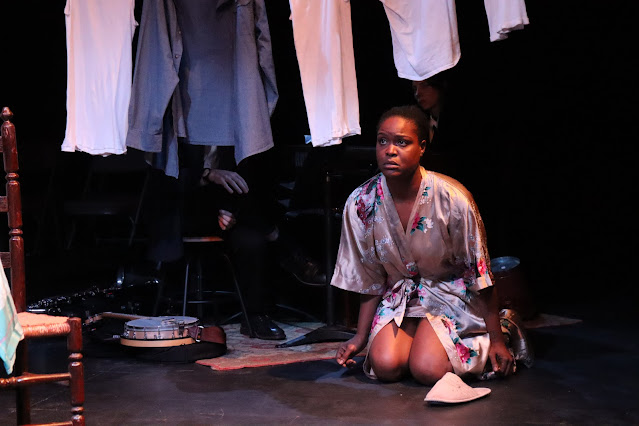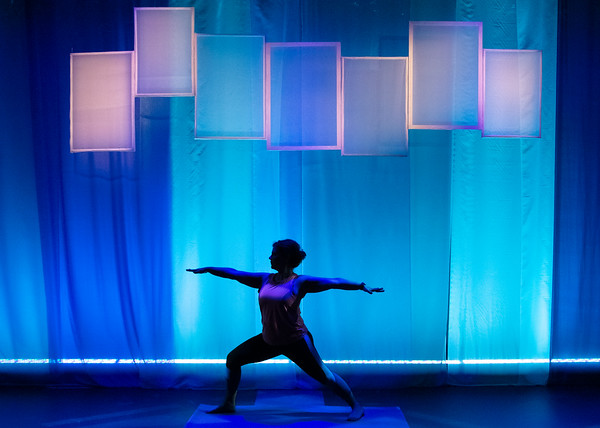At the Barricades
580 Sackett St., Brooklyn, NYC
June 12-29, 2025
 |
| The company. Photo by Pablo Calderón-Santiago |
It's not hard to see the timeliness of the exploration of antifascist struggle in 1930s Spain presented by James Clements and Sam Hood Adrain's world premiere play
At the Barricades when the day we saw the show was also marked in the United States by political assassinations and by nationwide protests against our own openly corrupt, increasingly fascist government. That government, in fact, rescinded an NEA grant for
At the Barricades (as it did for many other productions and arts organizations) for "not 'aligning with the president's priorities,'" forcing theater company What Will the Neighbors Say? to work with
IndieSpace to secure a community loan so that the production could be mounted as scheduled.
%20Stephanie%20Del%20Bino,%20Sam%20Hood%20Adrain%20and%20James%20Clements.jpg) |
| (L-R) Stephanie Del Bino, Sam Hood Adrain, and James Clements. Photo by Pablo Calderón-Santiago |
During the Spanish Civil War, 2,800 American volunteers, who would come to be called the Abraham Lincoln Brigade, joined the "
almost forty thousand men and women from fifty-two countries" of the International Brigades, organized by the Communist International, in order "
to help fight fascism." Set in the outskirts of Madrid in January 1937, about 6 months after the coup that resulted in the Spanish Civil War and Francisco Franco becoming dictator,
At the Barricades is a source-based history play developed through a partnership with the
Abraham Lincoln Brigade Archives (ALBA) and also drawing on the Tamiment Labor Archives. Focusing on six Republican fighters from different nations, the excellent
At the Barricades astutely and affectingly delves into not only their experience of the war but also why they came to Spain, what their lives were like before, and the conflict (ideological and otherwise) among them, much of which is historically situated while simultaneously applicable to liberation movements more broadly, including in our contemporary moment.
%20James%20Clements,%20Stephanie%20Del%20Bino,%20Edu%20Di%CC%81az%20and%20Devante%20Lawrence..jpg) |
| (L-R) James Clements, Stephanie Del Bino, Edu Díaz, and Devante Lawrence. Photo by Pablo Calderón-Santiago |
The play opens with its characters delivering an aural collage of their letters to family and loved ones before they all converge in the unit that we will follow over the course of a year. New to the war are Americans Victoria (Chelsie Sutherland), a nurse, and Anthony (Sam Hood Adrain), a student, both of whom are New Yorkers and members of the United States Communist Party. They join veteran international fighters Walter (
Devante Lawrence), a Black working-class man from Missouri, and Jim (James Clements), a white, working-class man from Glasgow, alongside native Spaniards Diego (
Edu Díaz), their captain, and Elena (Stephanie Del Bino), a former university professor. While there are moments of violence, staged with effective stylization, much of the volunteers' time is spent waiting, giving them plenty of opportunity to probe and debate with and learn about one another. At various points, various combinations of the sestet discuss topics including their expectations and motivations for joining the fight (structural racism, for example, figured significantly in Victoria's and Walter's decision to give up their passports and fight for a larger liberatory cause in a foreign nation); what Spain was like before the war; and even their romantic and sexual lives (leading to a couple of revelations that cut against heteronormativity). While these exchanges often facilitate and deepen bonds within the unit, they simultaneously raise difficult questions: Victoria interrogates Jim's relationship to empire, for example; Victoria and Walter butt heads over Stalinism versus Leninism and how far the ends justify the means; and Elena grills Diego about how they can feel justified in killing their own countrymen. In addition to facing the enemy, the characters must confront internal struggles as well, from the emergence of what we would today call PTSD in Anthony to a lack of supplies and support–but also a Republican lack of tolerance for dissent that seems ironically akin to the fascism that they are battling. And, as the war proceeds, added to anxieties about who one can trust is the worry about how to persist when theirs may be a losing cause.
 |
| Devante Lawrence. Photo by Pablo Calderón-Santiago |
Intersectionality figures significantly in the play: for instance, Victoria, as a Black woman raised in Arkansas, would have faced multiple forms of oppression in the United States; Jim's analogy between the class divide and racial segregation meets with strenuous disagreement from Walter; and Elena acerbically reminds Jim and Walter that there can be no workers' equality without women's equality. Linked to such complexities, At the Barricades near its end foregrounds both the grief and the paradoxes–how multiple, conflicting things can be true at the same time–of (this) war. These larger ideas are wonderfully anchored in the cast's embodiment of their characters as multidimensional individuals, from the rectitude and hope with which Lawrence invests husband and father Walter to the sorely challenged idealism and naivete of Hood Adrain's Anthony. Sutherland ensures that we sympathize with Victoria's hardline stances even if we don't agree with them, and Clements blends sensitivity with brashness as Jim, while Díaz brings moments of vulnerable openness to committed leader Diego and Del Bino compellingly traces Elena's confrontation with her growing moral discomfort. With few exceptions, all of the actors remain onstage even if not in a particular scene–perhaps in a cot, perhaps on guard duty, perhaps unlit–which maintains a feeling of everyone being confined together in the space: them with them and us with them. Seating the audience on three sides of Frank J. Oliva's fantastic set intensifies such feelings, as do superb lighting and sound design, by Adrian Yuen and Stephanie L. Carlin, respectively. Lighting and sound also powerfully punctuate the production's climactic moments, which offer a mix of finality and lack of closure appropriate to the play's subject. And in the end, At the Barricades lets us sit with silence and absence, a potent invitation to contemplation. A number of scenes prior to that conclusion, Victoria accuses Elena and people like her (people who theorize but do not act, comfortable people) of waiting to get involved in actively resisting fascism until it was too late–which should sound uncomfortably, urgently familiar to us, here, now.
-John R. Ziegler and Leah Richards

%20Stephanie%20Del%20Bino,%20Sam%20Hood%20Adrain%20and%20James%20Clements.jpg)
%20James%20Clements,%20Stephanie%20Del%20Bino,%20Edu%20Di%CC%81az%20and%20Devante%20Lawrence..jpg)




Excellent review! I went to the last performance and found it as intelligent and absorbing as the reviewers describe.
ReplyDelete